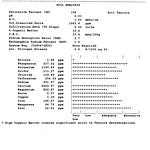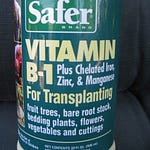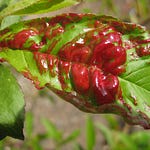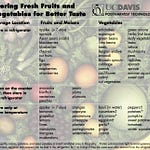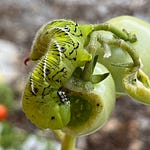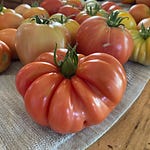In this podcast, retired college horticulture professor Debbie Flower explains about the use of rooting hormones and fertilizers for newly-installed plants. You’ll find out:
How rooting hormones work.
How auxins (the rooting stimulant in root hormones) can either inhibit or promote growth.
Why you don’t want to use rooting hormones on an established plant or transplant.
Why you want to cut the roots of a tree or shrub before planting.
Why you don’t want to add fertilizer at planting time.
The benefits of “paper hats” on new plantings.
And if you are using kelp or seaweed products as a root stimulator, you’d be better off spending your money on water and mulch. According to the Washington State University study, “The Efficacy and Environmental Consequences of Kelp-Based Garden Products” :
“• There is no documented benefit to applying plant hormones to newly planted or established plants in gardens and landscapes. Hormones are produced naturally by the plant and transported to the tissues that require them. The two most important additions new transplants require are water and mulch.
• Good quality research on kelp- containing biostimulants has been performed by several researchers in different climatic regions using different species of woody plants in natural settings. None of them reported success:
• Roots of newly planted trees treated with biostimulants showed no improved growth compared to control trees. (Barnes and Percival 2006; Gilman 2004; Popenoe et al. 2017).
• The best performing trees and shrubs were those that were irrigated frequently for 38 weeks post installation (Gilman 2004) or received a simple topdressing of pine bark mulch immediately after planting (Figure 3; Abbey and Rathier 2005).
Trees treated with biostimulants and assessed two years after planting were not significantly different than those receiving only water (Kelting et al. 1998).
No biostimulant was able to confer increased protection to shrubs and trees against drought or salt damage compared to plants treated with water (Banks and Percival 2014).
Researchers who tested biostimulants that were reported by local growers to be highly effective could find no evidence to support that belief (Popenoe et al. 2017). In fact, some of the products were worse than the controls. “
Click Here for the Farmer Fred Smart Pot Discount!
Here’s a transcript of today’s newsletter podcast:
Farmer Fred 0:00
Ray sent us an email, to Fred at farmerfred.com. He says, "I recently bought some fruit trees, and the label mentioned using a rooting stimulant for transplanting. In further research I found that certain root stimulants are illegal in California. Do you know why?" I bet it's because there's something else in that stimulant, Ray. The stimulants themselves may not be the problem. But with more information on that, we bring in America's favorite retired college horticultural Professor, Debbie Flower, who is probably going to snuff your dreams, right?
Debbie Flower 0:35
Root stimulants typically contain, not all of them, but typically contain synthetic auxin. Auxin is a plant hormone, it's produced by the plants, produced in the buds, which is why you don't always want to remove the buds at the tip of the stem. It's produced in the buds and it controls the growth of the plant. At certain concentrations, synthetic hormones will prevent growth. At other concentrations, it will promote growth. When it's applied externally to roots, it has different and fewer effects on the plant. It's not stimulating root growth per se. It's actually subduing above ground growth in favor of the roots growing.
Farmer Fred 1:15
Yeah, that sounds like the purpose of phosphorus.
Debbie Flower 1:18
Well, no. The auxin stimulators, IBA and NAA, are two of the auxin stimulants. If you put it on a broken stem or root, and there will be broken roots on a transplant, then it can be absorbed into the vascular system and do its job at the right concentration, stimulating cell growth. And so there is some of that going on. And that's why they're used in cuttings. But when you're just buying an already rooted plant, a healthy plant, applying the stimulant to the roots doesn't directly cause them to grow better. So that's one thing. Another is that root stimulants often contain fertilizer. And the ones that I found that were illegal in California, they don't say illegal, they just say 'Not for use in California", or, "Not registered for use in California". They have fertilizer in them, nitrogen, phosphorus and potassium. And excess fertilizer is a pollutant. It's the reason we get overgrowth of algae in streams and rivers. That overgrowth kills the life, the animal life, fish, frogs, whatever, in the water body, and we upset the ecosystem. And so the stimulants in California that have the fertilizer in them are not labeled for use in California. Growth regulators, which root stimulants are, are lumped in with pesticides as far as licensing is concerned. So they have to first be licensed by the US Environmental Protection Agency. And then at least in California, and in other states. I know New York, Maryland, Virginia, for sure. I'm sure there are lots of other states that go through this process as well. In California, it is the California Department of Pesticide Regulation. They have to then look at the product again, and decide whether it will be legal in the state. So different growth regulators are available in different states because the states have decided to allow them to be or to not allow them to be part of the product.
Farmer Fred 3:16
Ray mentioned one that has a lot of phosphorus in it. It was a 4-10-3, which means 4% nitrogen, 10% phosphate, 3% potash. Phosphate is not illegal in California yet. So I think the reason that it wasn't for use in California had to do with the instructions. And this goes back to what we always say, read and follow all label directions. This particular root stimulant said that you could not apply it on food crops. It was okay for ornamental plants, but not for food crops.
Debbie Flower 3:31
I read some items that also discussed grain and grass production, because those are done in big fields. So I think it was prohibited there as well.
Farmer Fred 4:00
Yeah, we're gonna see a lot less phosphorus on the shelves, I think. That big middle number is going to disappear, right?
Debbie Flower 4:07
We seen it disappear in laundry detergents, because of its ability to cause pollution in runoff. It's been a while now, but there was a worldwide shortage of phosphorus for a while. And we in horticulture and agriculture, at least some of us figured out, we don't need near as much as we thought we did to produce the plants. It cost money to buy fertilizers, so there was some natural cutback there. But yes, we need to take care of our planet. And unfortunately, Americans believe if a little is good, a lot is better. And that ends up as runoff and pollution.
Farmer Fred 4:49
So how can you naturally encourage roots to grow?
Debbie Flower 4:52
Have the proper soil. So that means it has the ability to hold moisture and nutrients and it drains well. Then water it appropriately. And that's gonna vary on your soil, your location, your sun-shade location, whether you're on a slope or not, you don't want it to dry out so completely that the roots can't grow and they die; and you don't want it to absorb so much moisture that they drown. So having the right media for your situation, and using the correct cultural practices,
Farmer Fred 5:22
We are fond of also saying on the show, "right plant in the right place" And we should point out, "right plant, right place, right time". You don't want to do any transplanting in the heat of the summer, or in very cold , wet wintry conditions. So consider that, too, to encourage roots to grow. Keep them relatively moist and let them get established. The other thing you've pointed out in past episodes, too, that bears repeating here is: when you are transplanting into the ground, discourage the use of fertilizer.
Debbie Flower 5:53
Yes, because it can burn. Whenever you transplant from a container, or if you're buying a ball and burlap, or if you're buying a bare root. In all cases, the roots have been or will be damaged in the process of planting them. The roots are also probably damaged when the commercial growers are getting the transplants out of the growing field. And you can't avoid that. That's just part of the game. In fact, it's encouraged that you at least cut the roots so that you don't have any circling, girdling, roots over time. So you're doing damage, then you put the plant in the ground. Now you've got open wounds in the root system, which can be burned by fertilizers when they're in the form that can be absorbed by the plant or in the salt form. It's not exactly the same thing, but think about if you pour salt in an open wound on your body. Okay, you don't want to do that to your plant. The part of the root system that absorbs the water and nutrients is the root hairs. They are the most delicate parts of the root. They're typically at the ends of the root, or the root branches. And they're right there and they get harmed in this process. So the plant kind of can't do anything for a few days. It takes a few days for them to produce new root hairs. You don't want anything to impede that. You don't want to burn those broken root parts. So, plant the plant, water it well, and then walk away. Or if it's possible, shade the plant for a few days. I've been known to make little caps out of newspaper and lay them on the plant and then hold them down with something just a rock. Sure, they blow away. I just go collect them. But it's just about three to five days that you need to shade, give the plant a little more shade, so it can produce new root hairs and be able to absorb the water.
Farmer Fred 7:41
When you were sick, as a youngster, I imagine that if you came home from school, and you didn't feel good, and you just sort of plopped down on the couch, mom or dad might throw a blanket over you. Not a bad idea after you've transplanted a plant, too, is maybe to add some mulch on top.
Debbie Flower 7:56
Yes, mulching the soil is always a good thing. Make sure it doesn't touch the trunk or where the stems of the plant go into the ground, because you don't want to trap moisture there and cause other problems. But mulch controls moisture loss. It prevents compaction from water hitting the soil from above. Because water can actually cause soil compaction. It breaks down if it's organic mulch, it breaks down and makes nutrition that the plant can use at a quantity that the plant can use. It's a very desirable thing to have organic mulch over your root systems.
Farmer Fred 8:31
And it helped keep weeds away, too.
Debbie Flower 8:32
Yes, it does.
Farmer Fred 8:34
All right. So there you go. Well, we hope that helps you as far as figuring out what you need to really get your plant off to a good start after you've transplanted that fruit tree into its new home. And you probably don't need to buy some sort of rooting hormone. So there you go. Debbie Flower, thanks so much for your help on this. You're welcome Fred.
Thank you for listening to the Garden Basics with Farmer Fred podcast! It’s available wherever you get your podcasts. Please share it with your garden friends.
As an Amazon Associate, I earn from qualifying purchases from some of the underlined links in the newsletter. This is how I am trying to keep this a free newsletter. And as long as you buy whatever you want from Amazon using any of those links to get into the Amazon site, I get a few pennies. Thank you.
Thanks for Subscribing and Spreading the Word About the Beyond the Basics: The Garden Basics with Farmer Fred newsletter, I appreciate your support.
Fred Hoffman is also a University of California Cooperative Extension Master Gardener in Sacramento County.







